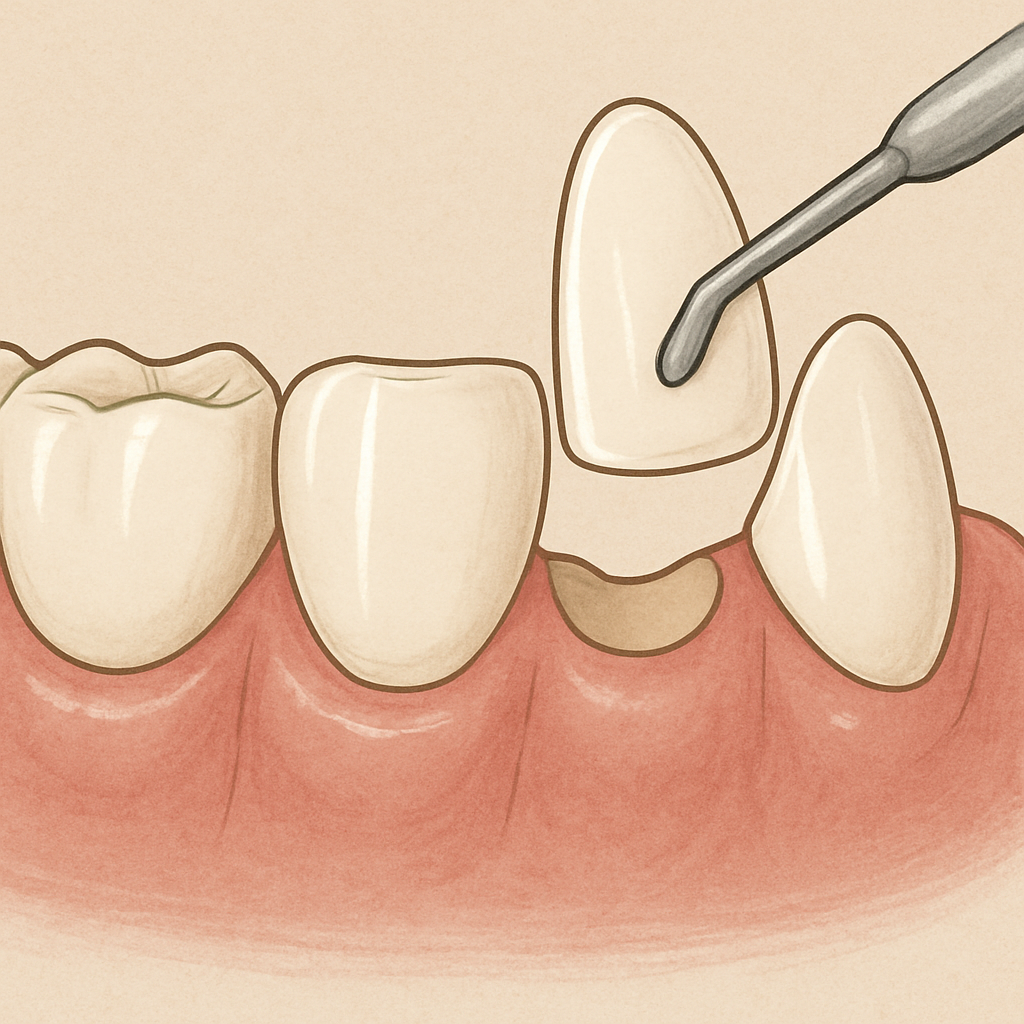
Trending Tags
Today's Stories
-

What happens to teeth under veneers
Read More: What happens to teeth under veneersWhen considering veneers for teeth, many people wonder what happens to their natural teeth once veneers are applied. This is an important question, as understanding the process can help you make an informed decision about whether dental veneers are the right choice for you. In this article, we’ll explore what veneers are, how they are applied, and what happens to your teeth beneath these cosmetic enhancements. We will also delve into the benefits and considerations of choosing veneers, and provide guidance on caring for them to ensure they remain a valuable part of your dental health strategy. Dental veneers are thin, custom-made shells designed to cover the front surface of your teeth. They are typically made from porcelain or composite resin materials and are intended to improve the appearance of your teeth by altering their color, shape, size, or length. Veneers are a popular choice for those looking to enhance their smile without undergoing more invasive procedures like braces or crowns. They provide a versatile solution to a range of cosmetic dental issues, from discoloration and minor misalignment to gaps and chips. There are mainly two types of veneers: porcelain veneers and composite resin veneers. Each type has its own advantages and considerations, making it important to evaluate which option best suits your needs and lifestyle. The Veneer Application Process Before diving into what happens to your teeth under veneers, it’s essential to understand the application process itself. This process is integral to achieving the desired aesthetic results and ensuring the longevity of the veneers. Initial Consultation The veneer application process begins with an initial consultation. During this visit, your dentist will discuss your cosmetic goals, examine your teeth, and determine whether you’re a good candidate for veneers. X-rays and impressions of your teeth may also be taken. This consultation is a critical step, as it allows your dentist to identify any underlying dental issues that need to be addressed before veneers can be applied. It’s also an opportunity for you to discuss any concerns or questions you may have about the procedure. Preparation of Teeth To apply veneers, your dentist will need to prepare your teeth. This involves removing a small amount of enamel from the surface of each tooth that will receive a veneer. This is done to ensure the veneers fit properly and look natural. The amount of enamel removed is typically minimal, often less than a millimeter. This preparation process is crucial, as it allows the veneers to sit flush against your teeth, creating a natural appearance and preventing issues such as misalignment or discomfort. While the thought of enamel removal may be daunting, it’s important to remember that this step is carefully controlled and performed with precision to maintain the health and integrity of your teeth. Making the Veneers Once your teeth are prepared, impressions are taken and sent to a dental laboratory, where your custom veneers are crafted. This process can take a few weeks, during which temporary veneers may be placed to protect your teeth. The crafting of veneers is a meticulous process, involving the selection of materials that best match the color and translucency of your natural teeth. The lab technicians work closely with your dentist to ensure the final product meets your specific aesthetic goals and fits perfectly within your mouth. Bonding the Veneers When your custom veneers are ready, you’ll return to the dentist for their application. The veneers are carefully bonded to your teeth using a strong dental adhesive. Your dentist will make any necessary adjustments to ensure a perfect fit and natural appearance. This bonding process is critical to the success of the veneers, as it ensures they remain securely attached and function like natural teeth. The adhesive used is specially formulated to provide a durable bond while being safe for oral use. Once the veneers are in place, your dentist will polish them to enhance their appearance and ensure they blend seamlessly with your natural teeth. What Happens to Teeth Under Veneers? Now that you understand the veneer process, let’s address what happens to the teeth beneath them. Understanding this aspect is essential for making an informed decision about whether veneers are the right choice for you. Protection and Preservation One of the primary benefits of veneers is the protection they offer to your natural teeth. The thin layer of porcelain or composite resin acts as a barrier, shielding your teeth from damage and decay. However, it’s essential to maintain good oral hygiene, as the natural teeth beneath the veneers are still susceptible to decay and gum disease. Regular brushing and flossing, along with routine dental check-ups, are crucial to preserving the health of your teeth under the veneers. The protective nature of veneers can also help prevent further damage to teeth that may have been weakened by previous dental issues. Alteration of Natural Teeth The application of veneers requires the removal of some enamel from your natural teeth. This process is irreversible, meaning that once you have veneers, you will always need them or another form of restoration to protect your teeth. It’s crucial to consider this permanency before deciding on veneers. While this alteration may seem significant, the benefits of veneers in terms of aesthetic enhancement and functional improvement can outweigh the drawbacks for many individuals. Discussing your long-term dental goals with your dentist can help you weigh the pros and cons effectively. Strengthening Effect While veneers themselves are not intended to strengthen teeth, they can have a positive effect on the structural integrity of teeth that are chipped or worn down. By covering damaged surfaces, veneers can prevent further wear and provide additional support. This strengthening effect can be particularly beneficial for individuals with teeth that have been compromised by previous dental work or injury. Veneers can help restore confidence in your smile by not only improving its appearance but also enhancing the overall stability of your teeth. Sensitivity Changes Some patients experience increased tooth sensitivity after getting veneers due to the enamel removal process. This sensitivity is usually temporary and can be managed with toothpaste designed for sensitive teeth. It’s important to communicate with your dentist about any discomfort you experience, as they can offer solutions to alleviate sensitivity. Over time, most patients find that their teeth adjust to the veneers, and sensitivity diminishes. Being proactive about managing this aspect can ensure a smoother transition to having veneers. Caring for Your Veneers To ensure the longevity and effectiveness of your veneers, proper care is essential. Here are some tips for maintaining your veneers and the health of your natural teeth. These practices are not only about preserving the aesthetic appeal of the veneers but also about maintaining overall dental health. Oral Hygiene Brush and floss your teeth regularly to prevent decay and gum disease. Use a non-abrasive toothpaste to avoid damaging the veneers. It’s important to be diligent about oral hygiene, as veneers do not protect against gum disease or cavities in the natural teeth. Regular oral care helps maintain the bond between the veneers and your teeth, ensuring they remain secure and effective. Regular Dental Check-ups Visit your dentist regularly for professional cleanings and check-ups. This will help maintain the health of your veneers and catch any potential issues early. Regular visits allow your dentist to monitor the condition of your veneers and the health of your teeth and gums. Early detection of any problems can prevent more serious issues from developing, saving you time and money in the long run.…
Latest Articles
-
What happens to teeth under veneers
Read More: What happens to teeth under veneersWhen considering veneers for teeth, many people wonder what happens to their natural teeth once veneers are applied. This is an important question, as understanding the process can help you make an informed decision about whether dental veneers are the right choice for you. In this article, we’ll explore what veneers are, how they are applied, and what happens to your teeth beneath these cosmetic enhancements. We will also delve into the benefits and considerations of choosing veneers, and provide guidance on caring for them to ensure they remain a valuable part of your dental health strategy. Dental veneers are thin, custom-made shells designed to cover the front surface of your teeth. They are typically made from porcelain or composite resin materials and are intended to improve the appearance of your teeth by altering their color, shape, size, or length. Veneers are a popular choice for those looking to enhance their smile without undergoing more invasive procedures like braces or crowns. They provide a versatile solution to a range of cosmetic dental issues, from discoloration and minor misalignment to gaps and chips. There are mainly two types of veneers: porcelain veneers and composite resin veneers. Each type has its own advantages and considerations, making it important to evaluate which option best suits your needs and lifestyle. The Veneer Application Process Before diving into what happens to your teeth under veneers, it’s essential to understand the application process itself. This process is integral to achieving the desired aesthetic results and ensuring the longevity of the veneers. Initial Consultation The veneer application process begins with an initial consultation. During this visit, your dentist will discuss your cosmetic goals, examine your teeth, and determine whether you’re a good candidate for veneers. X-rays and impressions of your teeth may also be taken. This consultation is a critical step, as it allows your dentist to identify any underlying dental issues that need to be addressed before veneers can be applied. It’s also an opportunity for you to discuss any concerns or questions you may have about the procedure. Preparation of Teeth To apply veneers, your dentist will need to prepare your teeth. This involves removing a small amount of enamel from the surface of each tooth that will receive a veneer. This is done to ensure the veneers fit properly and look natural. The amount of enamel removed is typically minimal, often less than a millimeter. This preparation process is crucial, as it allows the veneers to sit flush against your teeth, creating a natural appearance and preventing issues such as misalignment or discomfort. While the thought of enamel removal may be daunting, it’s important to remember that this step is carefully controlled and performed with precision to maintain the health and integrity of your teeth. Making the Veneers Once your teeth are prepared, impressions are taken and sent to a dental laboratory, where your custom veneers are crafted. This process can take a few weeks, during which temporary veneers may be placed to protect your teeth. The crafting of veneers is a meticulous process, involving the selection of materials that best match the color and translucency of your natural teeth. The lab technicians work closely with your dentist to ensure the final product meets your specific aesthetic goals and fits perfectly within your mouth. Bonding the Veneers When your custom veneers are ready, you’ll return to the dentist for their application. The veneers are carefully bonded to your teeth using a strong dental adhesive. Your dentist will make any necessary adjustments to ensure a perfect fit and natural appearance. This bonding process is critical to the success of the veneers, as it ensures they remain securely attached and function like natural teeth. The adhesive used is specially formulated to provide a durable bond while being safe for oral use. Once the veneers are in place, your dentist will polish them to enhance their appearance and ensure they blend seamlessly with your natural teeth. What Happens to Teeth Under Veneers? Now that you understand the veneer process, let’s address what happens to the teeth beneath them. Understanding this aspect is essential for making an informed decision about whether veneers are the right choice for you. Protection and Preservation One of the primary benefits of veneers is the protection they offer to your natural teeth. The thin layer of porcelain or composite resin acts as a barrier, shielding your teeth from damage and decay. However, it’s essential to maintain good oral hygiene, as the natural teeth beneath the veneers are still susceptible to decay and gum disease. Regular brushing and flossing, along with routine dental check-ups, are crucial to preserving the health of your teeth under the veneers. The protective nature of veneers can also help prevent further damage to teeth that may have been weakened by previous dental issues. Alteration of Natural Teeth The application of veneers requires the removal of some enamel from your natural teeth. This process is irreversible, meaning that once you have veneers, you will always need them or another form of restoration to protect your teeth. It’s crucial to consider this permanency before deciding on veneers. While this alteration may seem significant, the benefits of veneers in terms of aesthetic enhancement and functional improvement can outweigh the drawbacks for many individuals. Discussing your long-term dental goals with your dentist can help you weigh the pros and cons effectively. Strengthening Effect While veneers themselves are not intended to strengthen teeth, they can have a positive effect on the structural integrity of teeth that are chipped or worn down. By covering damaged surfaces, veneers can prevent further wear and provide additional support. This strengthening effect can be particularly beneficial for individuals with teeth that have been compromised by previous dental work or injury. Veneers can help restore confidence in your smile by not only improving its appearance but also enhancing the overall stability of your teeth. Sensitivity Changes Some patients experience increased tooth sensitivity after getting veneers due to the enamel removal process. This sensitivity is usually temporary and can be managed with toothpaste designed for sensitive teeth. It’s important to communicate with your dentist about any discomfort you experience, as they can offer solutions to alleviate sensitivity. Over time, most patients find that their teeth adjust to the veneers, and sensitivity diminishes. Being proactive about managing this aspect can ensure a smoother transition to having veneers. Caring for Your Veneers To ensure the longevity and effectiveness of your veneers, proper care is essential. Here are some tips for maintaining your veneers and the health of your natural teeth. These practices are not only about preserving the aesthetic appeal of the veneers but also about maintaining overall dental health. Oral Hygiene Brush and floss your teeth regularly to prevent decay and gum disease. Use a non-abrasive toothpaste to avoid damaging the veneers. It’s important to be diligent about oral hygiene, as veneers do not protect against gum disease or cavities in the natural teeth. Regular oral care helps maintain the bond between the veneers and your teeth, ensuring they remain secure and effective. Regular Dental Check-ups Visit your dentist regularly for professional cleanings and check-ups. This will help maintain the health of your veneers and catch any potential issues early. Regular visits allow your dentist to monitor the condition of your veneers and the health of your teeth and gums. Early detection of any problems can prevent more serious issues from developing, saving you time and money in the long run.…
-
Benefits of Joining a Body Corporate
Read More: Benefits of Joining a Body CorporateIn the realm of property ownership in Australia, the term ‘body corporate’ often surfaces. But what is a body corporate in Australia, and why should you consider joining one?A…
-
Understanding SDA Housing in Queensland
Read More: Understanding SDA Housing in QueenslandNavigating the housing market can be challenging. This is especially true for individuals with disabilities. In Queensland, a solution exists. It’s called SDA Housing. SDA, or Supported Disability Accommodation,…
-
How to Choose Local Tree Services
Read More: How to Choose Local Tree ServicesChoosing the right local tree service can be a daunting task. With so many options available, it’s easy to feel overwhelmed. But don’t worry. This guide is here to…
-
Top Golf Lessons to Improve Your Game
Read More: Top Golf Lessons to Improve Your GameGolf is a game of precision, strategy, and skill. It’s a sport that can be enjoyed by people of all ages and skill levels. In Brisbane, the golf scene…
-
Bunya mountains school camps
Read More: Bunya mountains school campsNestled in the heart of Queensland, Australia, the Bunya Mountains offer a unique and enriching experience for school camps. Imagine your students exploring ancient forests, learning about diverse ecosystems,…
-
How to Access My Aged Care Services
Read More: How to Access My Aged Care ServicesNavigating the world of aged care services can be a daunting task. The My Aged Care portal is designed to simplify this process.This online platform serves as a central…
-
Choosing the Right Lawnmower Battery
Read More: Choosing the Right Lawnmower BatteryLawnmower batteries come in various types, each with its own set of advantages and disadvantages. Understanding these differences can help you make a more informed choice. Here are the…
-
Benefits of Workplace Mediation Services
Read More: Benefits of Workplace Mediation ServicesIn the modern workplace, conflicts are inevitable. They can arise from various sources, such as miscommunication, personality clashes, or differing views on business decisions. When left unresolved, these conflicts…
-
Benefits of Reformer Pilates in Brisbane
Read More: Benefits of Reformer Pilates in BrisbaneIn the bustling city of Brisbane, a fitness trend is taking hold. It’s called Reformer Pilates, and it’s transforming the way people approach their health and well-being. Reformer Pilates…
Latest Posts











